.
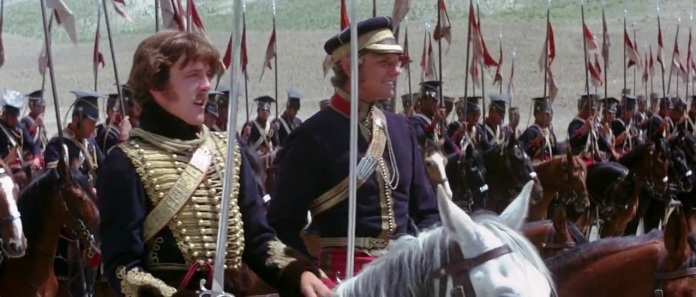
Director: Tony Richardson
By Roderick Heath
There are two films sharing the title of Alfred Lord Tennyson’s famous encomium to English heroism in the face of impossible odds. The first is the Michael Curtiz-directed, Errol Flynn-starring 1936 film, recasting the charge as a revenge mission aimed more at a nefarious Pakistani khan allied to the Russians than at the tsar’s armies themselves. It’s hugely entertaining, and it’s also complete and utter bunk, one of the ultimate examples of Hollywood’s romanticised version of British imperial history. More than 30 years later, the mood of the moviegoing public seemed to be incredibly different, so the second film to be called The Charge of the Light Brigade, helmed by Tony Richardson, was a radical departure. After a roaring start in films with Look Back in Anger (1959), The Entertainer (1960), A Taste of Honey (1961), and Loneliness of the Long Distance Runner (1962), Richardson had finally gained Oscar laurels for his 1963 reinvention of the historical movie, Tom Jones; ironically, it was only then that his career began to falter.

Like many of the other talents spawned by the British film industry in the era, his career was defined by an early continent of excellence and decades of variable output afterwards. Nonetheless, a lot of his work is today undervalued, and the most undervalued of all is his brilliant revisionist take on the infamous assault by Lord Cardigan’s cavalry on the Balaclava Heights on October 25, 1854. If Curtiz’s film offers lies that are hard not to love, Richardson’s tried to tell truths hard to stomach at any time. Richardson’s The Charge of the Light Brigade is very much a modish work of the late ’60s, balancing, like many of its contemporaries, unusual, almost clashing stylistic and intellectual impulses reflecting a war within the texture and assumptions of the film itself, rendering it a distinctively dialectic work. Charge moves blithely from coal-black satire of the British upper classes and militarism, to a lush romanticism, to a brand of raw, tactile realism.

In doing so, The Charge of the Light Brigade tries to recapture a bittersweet flavour in looking back at a summit era in British history, from a time when awareness of the finish of the imperial era and the changing social paradigm was provoking many new questions. At the same time, the hoary history offered a wealth of contemporary relevance in attacking whipped-up militaristic fervour, easily finding echoes of Vietnam and the Cold War in looking back to the last time Russia and the West squared off over the issue of some third party’s problems. The screenplay, the first draft of which was written by playwright John Osborne but finally only credited to Charles Wood, commences with Cardigan, played by Trevor Howard in a splendid performance mixing blockheaded arrogance and swaggering masculinity, surveying his smartly dressed troops, a voiceover privileging us to his personal beliefs about what makes a good soldier: “If they can’t fornicate, they can’t fight, and if they don’t fight, I’ll flog their backs raw!”
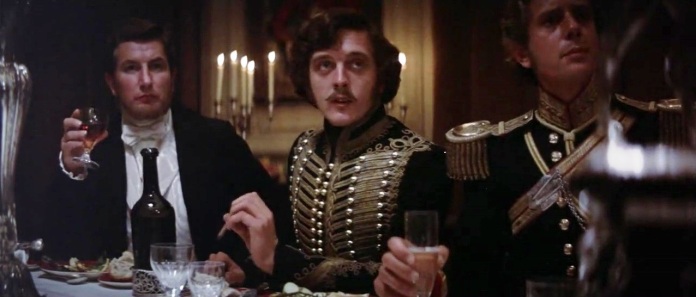
Richardson’s scabrous portrait of high imperial-era England is riddled with incompetent hereditary scions in important jobs and a general social philosophy that expects rich men to slap good-looking clothes on poor, roughly treated men to be used as cannon fodder, thereby making everything fine. The film commences a year or so before the Crimean War begins. Cardigan’s officers loll about indolently waiting for something to happen; fresh recruits are not so metaphorically beaten into shape to look good on parade. Cardigan has total contempt for the experienced, professionalised veterans who have served in India who comprise the only front-line troops in the British Army who have seen battle in the long, placid peace after the Napoleonic wars. This attitude puts him on a collision course with Capt. Louis Nolan (David Hemmings), a recently returned cavalry expert, who joins Cardigan’s regiment because his friend Capt. William Morris (Mark Burn) is already a member.

Nolan, after first getting Cardigan offside by having kept his Indian retainer and showing up his less competent officers, finally incurs some serious damage when hosting a friend at the officer’s mess by ordering a bottle of moselle. Because of the bottle’s near-black colour, Cardigan presumes this to be a “black bottle” of porter beer, a drink popular amongst cavalry officers of the time but banned by Cardigan as too common. Nolan is a principled, doggedly energetic young man determined to modernise the army, but also proud, self-righteous, and unremitting. Rather than apologise to Cardigan, he bucks for a court-martial to get the matter official attention, hoping to establish some sort of precedent, but Lord Raglan (John Gielgud) stalls embarrassedly and eventually talks him into taking a post with his office. Unfortunately, the matter has gotten out to the public, and mocking cries of “black bottle!” resound from the crowds when Cardigan goes out.
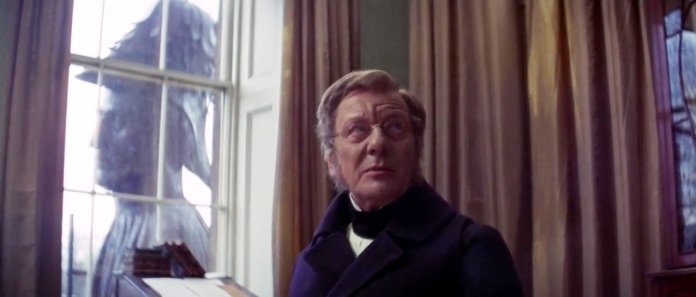
This tragicomic portrait of the peacetime army is punctuated by more broadly satiric scenes of the distracted, aged, almost senile Raglan, whose office is overshadowed by a huge statue of the Duke of Wellington on horseback temporarily parked outside it, and his staff, who are momentarily befuddled by war with Russia, with the French as allies, when all their maps and plans are intended for another war against France. In counterpoint to the travails and absurdities of the upper-class characters come vignettes of working-class men who join Cardigan’s regiment, focusing on Sgt.-Maj. Corbett (Norman Rossington). Corbett is a man who’s spent 20 years climbing to the highest noncommissioned rank, uses practised, persuasive patter to garner potential recruits out on the street, and bellows with impressive bellicosity once they’re in uniform; the least-educated have to be taught left from right by having straws planted on their feet.

Corbett is undone when Cardigan asks him to spy on Nolan and his friends to find out what they’re saying, a task Corbett immediately, near-tearfully declares an insult. Cardigan contemptuously dismisses him, and Corbett, who hasn’t drunk alcohol since being promoted in his pure dedication to his rank, immediately gets falling-down drunk before parading the men. This earns him a brutal flogging before the entire regiment: one junior officer faints, Nolan disdains, and fellow officer Mogg (Alan Dobie) retorts, “They will not fight unless they’re flogged to it. What would you ask them? Would you ask them to fight like fiends of hell for money, or for ideas? That would be un-Christian!” Richardson offers glimpses of the enlisted men’s cramped barracks, which they share with their families, their wives labouring at washing the glittering linen and uniforms Cardigan gives them.
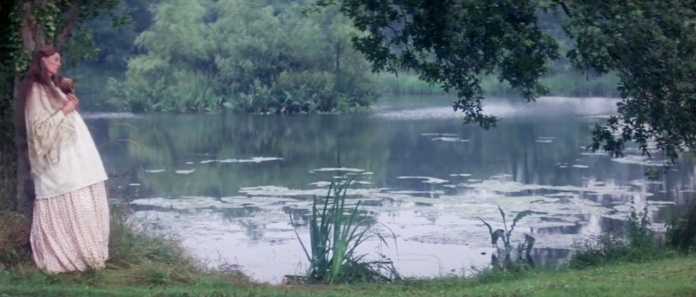
Almost inevitably for a film made at the height of the Swinging ‘60s, Richardson investigates period varieties of sexuality, bubbling in bawdy fashion under prim and flashy surfaces. Cardigan’s formula of fighting and fornication as entwined capabilities sees him teased for the brazen homoeroticism of his soldiers’ dress (“You see ’em tight, my cherry-bums? I keep ’em tight!”). Fanny (Jill Bennett), the wife of dim-witted Paymaster Duberly (Peter Bowles), lusts after Cardigan—one of her voiceovers informs us that her husband insists she stop looking at the general like she wants to be ridden by him. She finally bags him when the army is in the Crimea, the pair of them nonchalantly peeling off their clothes after getting rid of dinner guests, before, once in bed, Cardigan starts smacking Fanny’s backside to her horror/enthrallment, declaring in mortification, “This isn’t love!” before exploding with the giggles. Next morning, she packs her soldier-god off to battle with his aides, squeezing him into his corset and too-tight uniform.

On an entirely different level is the affair between Nolan and Clarissa Morris (Vanessa Redgrave), his friend’s wife, a tacit ménage à trois that’s part soldierly fellowship, part unspoken recourse after Morris’s sexual failure. When they’re disembarking, Morris gives Nolan a letter from Clarissa, calling it “orders from Her Majesty,” but Nolan tosses it overboard. The sequences depicting Clarissa and Morris’s wedding, and the subsequent lives of the trio, are exceptions from the visual texture and social structure of the rest of the film: with their country house and riverside environs, dappled sunlight and quaint churches, they live in a remnant of classical, earthy, lush William Blakeish England. Later, Clarissa, left alone by both her husbands, waits like a figure out of a pre-Raphaelite painting (specifically, if anachronistically, evoking John Byam Shaw’s The Boer War), pregnant and boding, waiting for their return, dancing on the grass lawn when she gets word from them.

Richardson wields a large, polished production befitting an old-fashioned epic with determinedly new wave cinematic techniques, employing jump- and cross-cutting, and discursive use of sound that shake up the way period detail is employed in a movie. Interspersed throughout The Charge of the Light Brigade are animated interludes by Richard Williams that wittily mimic Victorian engravings and newspaper cartoons, evoking the sweep of imperial enterprise and its heroic official imagery of industry and military, as well as the Crimean War’s emotive rhetoric. Britain is alternately characterised as a gallant lion acting as a policeman, heroine Britannia with armadas hidden up her skirts, and dozens of bulldogs ready to gnaw the marauding Russian bear to pieces. Turkey, the victim of Russian bullying, is both a bird being chased and a swooning maiden needing to be saved, a point echoed later in dialogue by Raglan.
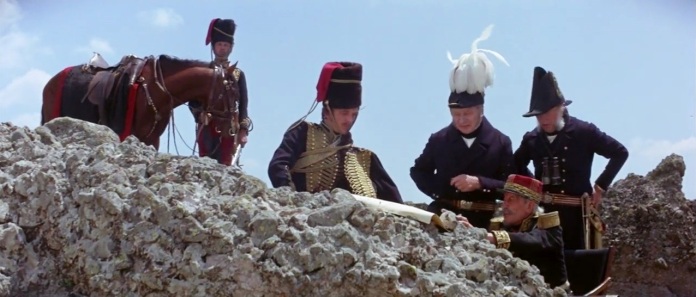
These are more than humorous, pop-art flourishes: they offer a broader context to the drama and excuse any need for cutaways to exposition-spouting politicians. They also lay bare the social outlook of high imperial Britain and its self-image, which the live-action parts both give the lie to and obey. The way Richardson and Williams zero in on the nature of propaganda and make it part of the texture of the film explain not only why the characters are going to war, but eye, with telling and perhaps now even more relevant analysis, the emotive rhetoric used to steer populations into wars that have no object relevance to them. John Addison’s brilliant score swirls in mock Olympian flourishes, with grand chorales, sweeping strings, and elegiac passages. Together, Richardson and Williams create a visual and aural moment of harmonious beauty when William’s animation portrays the British fleet sailing past Gibraltar, which turns into the British lion, Britannia, and mounted Wellington pointing the way.

Cardigan and his officers, when out riding, gleefully charge a peace rally, smashing down their placards. Hemmings’ Nolan, with his proto-counterculture home life and frustrated desire to reform the army and take on the elderly blowhards, clearly stands in for the ’60s youth movement. When the army heads off to war, the film becomes a kind of Gilbert and Sullivan operetta without the music, and with lots of men dying because of the comedy. Cardigan loathes his brother-in-law Lord Lucan (Harry Andrews), who’s placed in supreme command of the expeditionary force’s cavalry. In spite of Raglan’s entreaties, they continue their petty bickering in the field, forcing the men under their commands to pull down their tents constantly and erect them again at differing spaces apart to gall each other. Raglan aggravates them even further by keeping them out of battles, for which they’re basically pretty window dressing.

The London Times correspondent William Russel (T. P. McKenna), whose reports from the front are considered pioneering instances of what we now call embedded journalism, advises “You shouldn’t believe everything you read in The Times, you know,” when triumphant reports appear in the paper that the army has captured Sebastopol when it’s actually still encamped outside it, as the official narrative of the army riding to the rescue needed its instant, orgasmic consummation. The film’s bitterly realistic streak presents horses battered to death in the holds of the transport ships being dumped overboard in job lots, and the army columns, after moving out from their landing point in a gallant show, are seen later riddled with men withering and dropping into agonised bundles from heatstroke and cholera. One panoramic camp scene finds men blithely playing cricket and others having their shattered limbs hacked off.
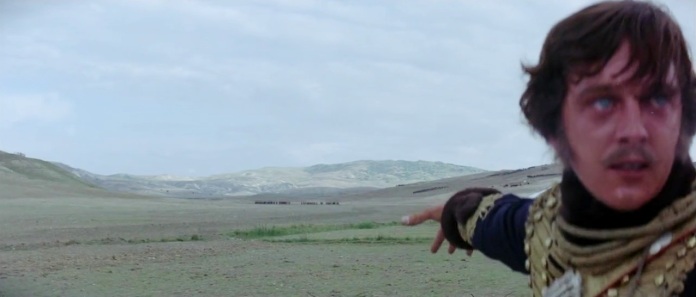
Raglan has his soldiers march up a near-sheer cliff to sweep some Russians off the heights, finishing up with hundreds of men sprawled in bloody masses, whilst Raglan responds with distaste to Nolan’s insistent, pushy addresses, stating, “That young man Nolan, I don’t really like him. He rides too well, knows a lot, but he has no heart. It’ll be a sad day when England has her armies officered by men who know too well what they’re doing. It smacks of murder.” There’s something of the remnant spirit of The Life and Death of Colonel Blimp (1943) in the film’s corrosive mix of irony and wry empathy for such outmoded, strangely idealistic foolishness, but it’s no longer mediated by the communal spirit of WWII, but by the furious mood of the 1960s. The Charge of the Light Brigade is an irate film partly concealed by its playful touches.
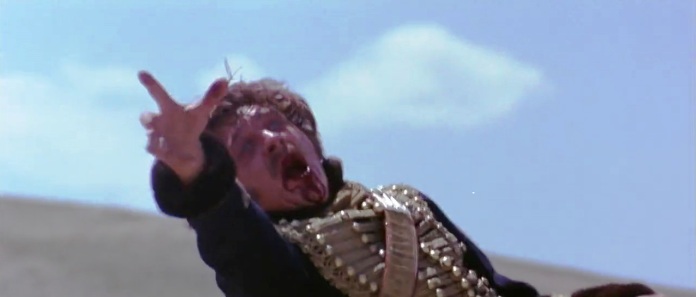
Interestingly, the film decries the callous incompetence of the old school of militarism, but finally, shows itself to be equally suspicious of a more modern, businesslike version represented by Nolan. His pushiness and barely repressed fury with the men in charge sees him goad Lucan and Cardigan into action when conveying an order from Raglan to flank a Russian artillery position. Lucan and Cardigan assume, in spite of their uncertainty, he means they’re to attack the position, thus commencing the infamous charge. Nolan realises their mistake and tries to alert them, but a shell explodes overhead, and, in the film’s most bitterly, horrifyingly pointed moment, Nolan is killed. Richardson’s cutting here (one of his editors was Kevin Brownlow, the director and film archivist), and the use of manipulated sound, is startling, leaping from a shot of the exploding shell, to Nolan being hit, to a close-up of Raglan lifting into the frame as he watches in shock from afar, and then back to Nolan, coughing blood, his dying scream resounding as he still tries to warn the cavalry before dropping dead to the ground.

It’s a masterful little moment that rams home the shock of violent death and raises a curtain on a tragedy. Richardson’s shooting of the war sequences was criticised in some quarters, but he wasn’t after the sort of illustrative, thrilling clarity Curtiz and his action directors were going for in their version, or in most other war films. Especially in the climactic scenes, Richardson alternates distant, almost painterly shots that reproduce the views of observing commanders, artists and reporters of almost serene action, and then plunges into the midst of that action, with telephoto lenses, forced perspective, and rapid editing used to present a whirl of frantic motion, blood, murder, explosions, dust, and chaos.

The resulting vision is of a kind of warfare usually viewed through romanticised lenses as brutal, churning, bludgeoning, and hideous. The survivors of the charge, caked in blood and soot, stumble out of clouds of dust and smoke like they’ve been hurled in a hurricane. The film’s most vicious dialogue, which serves as an epitaph of sorts, comes when Cardigan, emerging from battle with the remnants of his troops demands to know where Nolan is so he can bust him for screaming “like a woman,” and is informed that he just rode over his dead body. The kicker there is the line is absolutely true. The film leaves off with the officers arguing worriedly about who exactly will take the blame for the miscued command in the battlefield littered with broken men and horses, waiting for the poets to step in make some sense of it all.

It’s worth noting, I think, that Basil Dearden’s Khartoum came out at the same time. Straightforward rather than satirical, but also with (still) contemporary relevance, in its portrayal of British imperialism and “heroism”.
LikeLike
Well, Khartoum was two years earlier, and I see it perhaps more as an evolution towards this sort of film from more standard heroic epics, as it’s still got a mostly “period high adventure” tone – but yes, it’s quite complex and biting in its commentary on the differing brands of fanaticism offered by Gordon and the Mahdi, and the portrayal of how the war is whipped up back in England.
Also, does anyone else think this film gave some licence to the Monty Python crowd?
LikeLike
I’m not sure how much this owes to the fine historical examination, “The Reason Why, Story of the Fatal Charge of the Light Brigade”, by Woodham-Smith, published in 1953 – which is the best source for the actual happenings and was supposedly a source for the script in this film, or if it’s simply a blueprint for Fraser’s later satirical novel “Flashman at the Charge” where the gutless Flashman is dragged into the Crimean.
I liked this film enormously anyway, even tho it’s diametrically opposed in both real life and as a film to “Zulu”, Cy Enfield’s Western…er…”historical” version of Roarke’s Drift part of the Empire’s legends, where intelligence and superior officers made a huge difference in the outcomes of the two battles. TCOTLB was supposedly much more concerned with verisimilitude than “Zulu”, and yet took almost as much license as the other film, but mostly in the sex and debauchery dept.
When Cardigan took over the 11th Hussars – “The Cherry-pickers”, they were the only ones wearing red trousers at The Charge – there was a general rush for the door by officers cognizant of Cardigan’s history and habits, and who had no wish to die of incompetence. The 11th eventually became one of the most decorated regiments in the BA, it’s too bad the appalling mistakes of its and other units commanders were required to change much of the structure of command back then, altho it wasn’t instantaneous, and should’ve happened earlier.
The two films have an amazingly different look to them, even tho only 5 years separated “Zulu” and TCOTLB, the former looking much more Studio than the latter. Curiously, they both can stand in for the perceptions of the Vietnam War of their respective times – “Zulu” a heroic last stand, like a Green Beret Adviser’s fort attacked by the Viet Cong in the early phases, TCOTLB a bitter examination of the failures of command that seemed to be the outcome of the whole SEA enterprise regardless of body counts.
The acting was slightly hammy at times, I think the lack of subtlety attributed to the real persons portrayed became some sort of permission to chew scenery down to the nubbin, but the scenes of bitter fighting were almost unrivaled at the time, i remember it created quite a stir. And face it, the uniforms were made for popinjays and main-chancers to parade around in, seemingly made for filming.
Excellent review, Rod!
LikeLike
Vanwall might note The Reason Why cited as a source in the film’s opening credits. Great review Rod
LikeLike
love the movie- esp. Riding Master Mogg – Alan Dobie The ‘ Late’ Charles Wood said the Bravest Man I’ve ever met – He gets right where others don’t – i so Argee
LikeLike